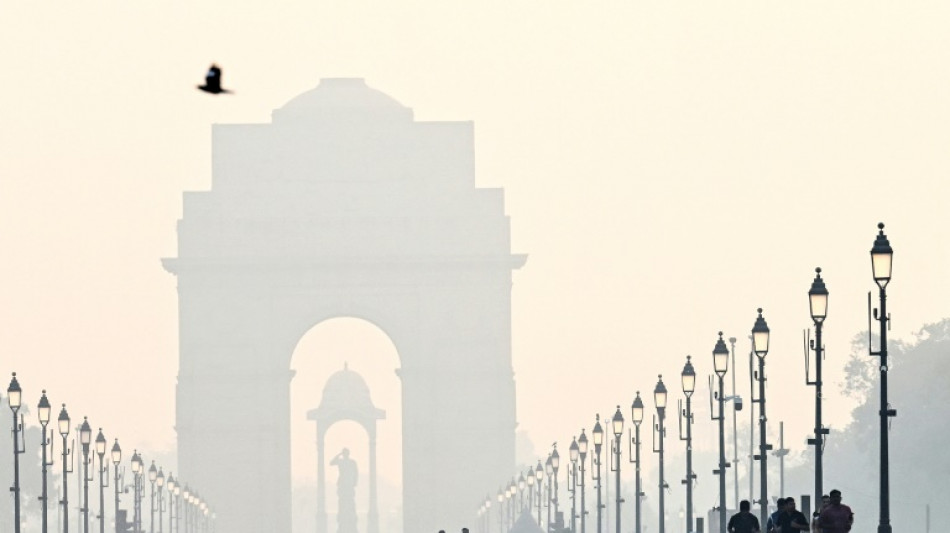
RYCEF
0.1700


The toxic smog season in India's capital has just begun, but those unable to escape cancer-causing poisonous fumes say the hazardous impact on health is already taking its toll.
New Delhi regularly ranks among the world's most polluted capitals, with a melange of factory and vehicle emissions exacerbated by agricultural fires blanketing the city each winter, stretching from mid-October until at least January.
Cooler temperatures and slow-moving winds trap deadly pollutants, suffocating the megacity of 30 million people in putrid fumes.
Factory worker Balram Kumar returns home exhausted from work, but then is up all night coughing.
"I am barely able to sleep all night," Kumar, 24, told AFP as he waited outside a special pollution clinic, set up at the government-run Ram Manohar Lohia hospital.
"My chest hurts every time I cough. I have been taking medicines but there is no relief," said Kumar.
He pointed dejectedly to an X-ray of his chest.
"My cough is just not going," he said.
- Thousands of deaths -
On Tuesday, the level of PM2.5 particles -- the smallest and most harmful, which can enter the bloodstream -- topped 278 micrograms per cubic metre, according to monitoring firm IQAir.
That is 18 times the daily maximum recommended by the World Health Organization.
On the worst days, levels can shoot up as high as 30 times the daily maximum.
Piecemeal government efforts to mitigate the smog, such as a public campaign encouraging drivers to turn off their engines at traffic lights, have failed to make an impact.
A study in the Lancet medical journal attributed 1.67 million premature deaths to air pollution in the world's most populous country in 2019.
Air pollution in Delhi has worsened after a fireworks ban was widely flouted for raucous celebrations last week for the Hindu festival of lights, Diwali.
The cracker frenzy turned Delhi's winter skies dull grey.
Doctor Amit Suri, who heads the pollution clinic, said there is usually a surge of 20-25 percent in the number of patients turning up with respiratory issues after the festival.
This year, it is the same story.
"Most of the patients are coming with complaints of dry cough, throat irritation, running of eyes and some of them are also having skin rashes," Suri told AFP.
The hospital provides treatment and medicine free of cost.
None of its patients can afford private healthcare, and many cannot buy an air purifier for their homes.
The WHO says that air pollution can trigger strokes, heart disease, lung cancer and other respiratory diseases.
- 'How will I survive?' -
A study published in the Lancet Planetary Health journal in July said more than seven percent of all deaths in 10 of India's biggest cities were linked to air pollution.
Delhi was the worst offender, with 12,000 annual deaths linked to air pollution -- or 11.5 percent of the total.
India's Supreme Court last month ruled that clean air was a fundamental human right, ordering both the central government and state-level authorities to take action.
But critics say arguments between rival politicians heading neighbouring states -- as well as between central and state-level authorities -- have compounded the problem.
"We need to create awareness," said doctor Ajay Shukla, the hospital's medical superintendent. "The problem is getting bigger by the day."
On the worst days, Shukla said, it is like chain-smoking cigarettes.
Doctors have been counselling the patients and providing a list of what to do to alleviate the health issues.
The main advice is to try and stay indoors, shut doors and windows, and wear anti-pollution masks while outside.
But Kanshi Ram, a 65-year-old daily wage labourer visiting the clinic, said he did not know what he should do to ease his nagging cough, which has kept him off work this week.
"Doctors are asking me not to go out and breathe the polluted air," Ram, who earns 500 rupees ($6) for each day that he works.
"But how will I survive if I don't go out?" he added. "I feel so helpless."
M.Saito--JT